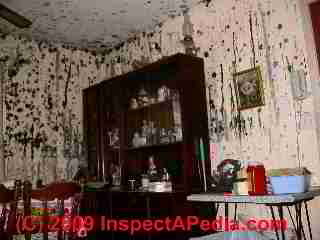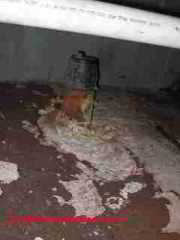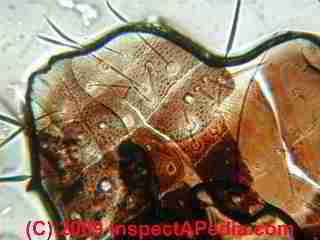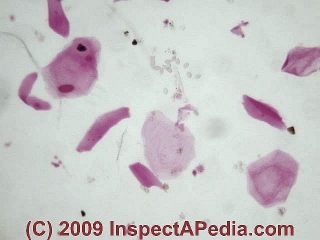 Guide to Biological Pollutants in Building Indoor Air
Guide to Biological Pollutants in Building Indoor Air
- POST a QUESTION or COMMENT about identifying, testing, cleaning, or removing biological contaminants found in buildings
List of Biological Contaminants or Pollutants Found Indoors:
Here we provide a summary of common indoor biological contaminants such as mold, animal dander, pollen, viruses, and bacteria. We explain the requirements to remove these materials to improve indoor air quality and other health conditions in buildings.
InspectAPedia tolerates no conflicts of interest. We have no relationship with advertisers, products, or services discussed at this website.
- Daniel Friedman, Publisher/Editor/Author - See WHO ARE WE?
A Quick Guide to Indoor Biological Pollutants

Suggestions for Reducing Exposure to Biological Pollutants Indoors. Biological contaminants as indoor air quality hazards. Removing or keeping out indoor contaminants. Home ventilation strategies. Best methods for cleaning & filtering indoor air.
Our page top photo shows an obviously moldy building that needs professional cleaning. But other mold and biological contaminants may be more difficult to spot..
Our photographs above show common sources of indoor biological pollutants including an un-discovered sewage backup in a crawl space (above left) and cockroach fragments and fecal dust (above right).
This article includes excerpts or adaptations from Best Practices Guide to Residential Construction (Steve Bliss, J Wiley & Sons) , by Steven Bliss, courtesy of Wiley & Sons.
For help looking for less obvious indoor mold contamination
see MOLD APPEARANCE - WHAT MOLD LOOKS LIKE.
Also
see ENVIRONMENTAL HAZARDS - INSPECT, TEST, REMEDY for our full list of environmental hazard identification and remedy related to buildings
Biological pollutants are or were living organisms. At least some of these are found in every home.
Common examples include molds, pollen, dust mites, animal dander, and cockroaches, as well as viruses and bacteria.
Our photo above shows gross evidence of a sewer backup in a crawl space that was ignored by the building owner, leaving a pathogenic hazards in the building (above left), and a cockroach fragment found in building dust (below left).
 Whether these
biological hazards and particles are brought in to the building inadvertently by humans or pets or ride
along on houseplants or their soil, living organisms tend to
stay longer and breed more successfully in warm, damp
conditions.
Whether these
biological hazards and particles are brought in to the building inadvertently by humans or pets or ride
along on houseplants or their soil, living organisms tend to
stay longer and breed more successfully in warm, damp
conditions.
In fact, given temperatures of 50°F to 90°F and a material that stays wet for more than 48 hours, a colony of mold or other fungi will rapidly develop from their invisible spores, which are everywhere in our environment just waiting for the right conditions to spring to life.
Health Effects.
Allergic reactions are among the most common health problems associated with indoor air quality.
They are often connected with molds, pollen, animal dander (mostly from cats and dogs), and dust mites, which are microscopic animals living in carpets, bedding, and furnishings. Allergic reactions can range from annoying to life-threatening, as in a severe asthma attack.
Common symptoms include watery, itchy eyes, runny nose, sneezing, nasal congestion, coughing and breathing difficulties, headaches, and fatigue.
Asthma. Children and adults with asthma are particularly at risk.
Asthmatics have very sensitive airways that react to irritants by narrowing, making breathing difficult.
Between 1980 and 1994, asthma rates in the United States rose by 75%, affecting over 20 million people today, including over 6 million children, according to the Centers for Disease Control and Prevention.
 Our lab photo (left) shows skin cells and dog dander particles, dyed red with acid fuchsin for clarity.
Our lab photo (left) shows skin cells and dog dander particles, dyed red with acid fuchsin for clarity.
Asthma “triggers”
vary from person to person, but some of the most common indoor triggers are biological allergens, such as dust mites; molds; animal dander, urine, and saliva; and cockroach body parts, secretions, and droppings.
at ALLERGENS in buildings, RECOGNIZING we provide additional field and laboratory photographs of common indoor allergens.
Suggestions for Reducing Exposure to Biological Pollutants Indoors
Since most biological pollutants thrive in a moist environment, the key to reducing them is good moisture control.
This starts with building houses correctly with good foundation drainage and waterproofing, proper flashings, continuous air and vapor barriers, and adequate ventilation. Household humidity levels should be maintained between 30% and 50%.
Basements should only be finished if they are dry year-round and detailed so finish materials and carpeting are not wetted by capillary action or condensation. If a building sustains water damage for any reason, it is essential that the wet materials be dried or removed within 24 to 48 hours or mold will grow. While wood, concrete, and other solid materials can be cleaned and disinfected, porous materials should be removed and replaced.
HVAC equipment and appliances that come in contact with water are other breeding grounds for biological contaminants. Have all such equipment serviced regularly and keep filters clean.
Air conditioners can help filter out pollen, but dirty coils and drain pans can also become a source of biological pollutants. If using humidifiers, clean them according to manufacturers’ instructions and refill with fresh water daily.
Evaporation trays in air conditioners, dehumidifiers, and refrigerators should also be cleaned frequently.
Duct cleaning may also be justified if an occupant is suffering from allergies and a visual inspection reveals that the air ducts are contaminated with large deposits of dust or mold. If so, choose a reputable company that follows the standards of the National Air Duct Cleaners Association (NADCA).
Good housekeeping is also an important part of the strategy for controlling household allergens.
Bedding should be washed at 130°F. Using a HEPA vacuum or central vacuum with an exterior exhaust is recommended. Minimizing the use of carpeting, upholstered furniture, and dust-collecting shelving and furnishings can also help by eliminating hiding places for dust and contaminants.
See details at CARPETING & INDOOR AIR QUALITY
In some case, portable or central air filtration may also play a role, but these are not a panacea for removing allergens.
See details at AIR FILTERING STRATEGIES
- - Adapted with permission from Best Practices Guide to Residential Construction (Steve Bliss, J Wiley & Sons) .
Common Sources of Biological Pollutants Indoors
According to the US EPA,
... indoor levels of pollutants may be 2-5 times, and occasionally more than 100 times higher than outdoor levels. These levels of indoor air pollutants may be of particular concern becaus3e it is estimated that most people [in the U.S.] spend about 90% of their time indoors.
Comparative risk studies performed by EPA and its Science Aedvisory Board have consistently ranked indoor air pollution among the top five environmental health risks to the public. [5]
Basic checks for sources of biological contaminants in buildings: Here we provide biological contamination troubleshooting help for buildings by expanded annotated information from the US EPA [5] who provided suggestions for investigating for biological pollutant sources during an indoor air quality investigation.
- Are animals or fungi (mold) present in the building?
See ANIMAL ENTRY POINTS in BUILDINGS
and also MOLD APPEARANCE - WHAT MOLD LOOKS LIKE
and see ALLERGENS in BUILDINGS - home - Is there a mold or "mildew" odor in or near the complaint area?
See MVOCs & MOLDY MUSTY ODORS as well as
our complete odor troubleshooting guide beginning
at ODORS GASES SMELLS, DIAGNOSIS & CURE - Is there standing water (or are there wet areas) near the complaint area, such as a wet crawl space or basement, or an air conditioner condensate drain system that is not working?
See CONDENSATE HANDLING, HVAC
and WATER ENTRY in BUILDINGS - Has there ever been a sewage backup or have there been toilet overflows in the building?
See SEWAGE CONTAMINATION in BUILDINGS - Is there condensation often present or seasonally present on windows or on other cold surfaces such as water piping and water tanks in or near the complaint area?
See CONDENSATION on WINDOWS & SKYLIGHTS - Is the indoor relative humidity level often above 60%?
See HUMIDITY CONTROL & TARGETS INDOORS. - Are there contagious occupants nearby in the building? Consult with appropriate physicians and health experts.
- Is the building served by a private well?
See WELL POLLUTION
...
Continue reading at BIOLOGICAL POLLUTANTS in the HOME - EPA or select a topic from the closely-related articles below, or see the complete ARTICLE INDEX.
Or see these
Recommended Articles
- AIR POLLUTANTS, COMMON INDOOR
- ALLERGENS in BUILDINGS - home
- INDOOR AIR QUALITY IMPROVEMENT GUIDE - home
- MOLD CLEANUP GUIDE- HOW TO GET RID OF MOLD - home
Suggested citation for this web page
BIOLOGICAL POLLUTANTS at InspectApedia.com - online encyclopedia of building & environmental inspection, testing, diagnosis, repair, & problem prevention advice.
Or see this
INDEX to RELATED ARTICLES: ARTICLE INDEX to BUILDING INDOOR AIR QUALITY IAQ
Or use the SEARCH BOX found below to Ask a Question or Search InspectApedia
Ask a Question or Search InspectApedia
Questions & answers or comments about identifying, testing, cleaning, or removing biological contaminants found in buildings
Try the search box just below, or if you prefer, post a question or comment in the Comments box below and we will respond promptly.
Search the InspectApedia website
Note: appearance of your Comment below may be delayed: if your comment contains an image, photograph, web link, or text that looks to the software as if it might be a web link, your posting will appear after it has been approved by a moderator. Apologies for the delay.
Only one image can be added per comment but you can post as many comments, and therefore images, as you like.
You will not receive a notification when a response to your question has been posted.
Please bookmark this page to make it easy for you to check back for our response.
IF above you see "Comment Form is loading comments..." then COMMENT BOX - countable.ca / bawkbox.com IS NOT WORKING.
In any case you are welcome to send an email directly to us at InspectApedia.com at editor@inspectApedia.com
We'll reply to you directly. Please help us help you by noting, in your email, the URL of the InspectApedia page where you wanted to comment.
Citations & References
In addition to any citations in the article above, a full list is available on request.
- "IgG Food Allergy Testing by ELISA/EIA, What do they really tell us?" Sheryl B. Miller, MT (ASCP), PhD, Clinical Laboratory Director, Bastyr University Natural Health Clinic - ELISA testing accuracy: Here is an example of Miller's critique of ELISA - www.betterhealthusa.com/public/282.cfm - Townsend Letter for Doctors and Patients
The critique included in that article raises compelling questions about IgG testing assays, which prompts our interest in actually screening for the presence of high levels of particles that could carry allergens - dog dander or cat dander in the case at hand.
- www.tldp.com/issue/174/IgG%20Food%20Allergy.html - contains similar criticism in another venue but interestingly by the same author, Sheryl Miller. Sheryl Miller, MT (ASCP), PhD, is an Immunologist and Associate Professor of Basic and Medical Sciences at Bastyr University in Bothell, Washington. She is also the Laboratory Director of the Bastyr Natural Health Clinic Laboratory. - Allergens: Testing for the level of exposure to animal allergens is discussed at http://www.animalhealthchannel.com/animalallergy/diagnosis.shtml (lab animal exposure study is interesting because it involves a higher exposure level in some cases
- [5] US EPA - Mold Remediation in Schools and Commercial Building [ copy on file as /sickhouse/EPA_Mold_Remediation_in_Schools.pdf ] - US EPA
- A BRIEF GUIDE to MOLD, MOISTURE, and YOUR HOME, [PDF] U.S. Environmental Protection Agency US EPA - includes basic advice for building owners, occupants, and mold cleanup operations. See http://www.epa.gov/mold/moldguide.htm
- US EPA - UNA BREVA GUIA a MOHO / HONGO - en Espanol
- Offermann, Francis (Bud) J., P.E., C.I.H., ASHRAE & Mark Nicas, Ph.D., MPH, C.I.H., USE WITH ADEQUATE VENTILATION ? [PDF], ASHRAE Journal, May 2018, also available as a PDF here with permission of the authors.
- Atlas of Clinical Fungi, 2nd Ed., GS deHoog, J Guarro, J Gene, & MJ Figueras, Centraalbureau voor Schimmelcultures, Universitat Rovira I Virgili, 2000, ISBN 90-70351-43-9
- Fifth Kingdom, Bryce Kendrick, ISBN13: 9781585100224, - we recommend the CD-ROM version of this book. This 3rd/edition is a compact but comprehensive encyclopedia of all things mycological. Every aspect of the fungi, from aflatoxin to zppspores, with an accessible blend of verve and wit. The 24 chapters are filled with up-to-date information of classification, yeast, lichens, spore dispersal, allergies, ecology, genetics, plant pathology, predatory fungi, biological control, mutualistic symbioses with animals and plants, fungi as food, food spoilage and mycotoxins.
- Fungi, Identifying Filamentous, A Clinical Laboratory Handbook, Guy St-Germain, Richard Summerbell, Star Publishing, 1996, ISBN 0-89863-177-7 (English)
- Mycology, Fundamentals of Diagnostic, Fran Fisher, Norma B. Cook, W.B. Saunders Co. 1998, ISBN 0-7216-5006-6
- In addition to citations & references found in this article, see the research citations given at the end of the related articles found at our suggested
CONTINUE READING or RECOMMENDED ARTICLES.
- Carson, Dunlop & Associates Ltd., 120 Carlton Street Suite 407, Toronto ON M5A 4K2. Tel: (416) 964-9415 1-800-268-7070 Email: info@carsondunlop.com. Alan Carson is a past president of ASHI, the American Society of Home Inspectors.
Thanks to Alan Carson and Bob Dunlop, for permission for InspectAPedia to use text excerpts from The HOME REFERENCE BOOK - the Encyclopedia of Homes and to use illustrations from The ILLUSTRATED HOME .
Carson Dunlop Associates provides extensive home inspection education and report writing material. In gratitude we provide links to tsome Carson Dunlop Associates products and services.

